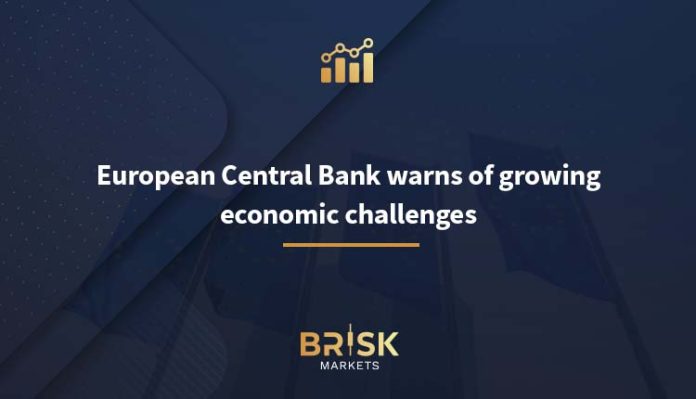The European Central Bank has issued a stark warning about the economic pressures facing the eurozone, as strict financial conditions have put pressure on everything from households to banking institutions. The European Central Bank’s recent Financial Stability Review paints a picture of a challenging financial landscape, including interest rate increases and ongoing geopolitical tensions affecting markets globally.
The report, released today, calls for increased vigilance in the face of these difficulties. ECB Vice President Luis de Guindos stressed the importance of strengthening macroprudential policies to protect against market sensitivities and vulnerabilities within non-bank financial institutions.
Despite some gains made by banks due to higher interest rates, they are struggling against rising operating costs and deteriorating asset quality. The tightening of the credit environment has led to a decline in lending activity, further complicating the situation for banks. However, their flexibility is supported by the mandates of macroprudential authorities to strengthen the protective margins.
The residential real estate sector is facing a downturn due to increased mortgage expenses, while commercial real estate is suffering from lower demand in the wake of the pandemic. In response to these challenges, the ECB calls for the full adoption of Basel 3 reforms and the completion of the banking union to strengthen the financial system.
Earlier this year, the European economy was shaken by the collapse of Credit Suisse, along with concerns about contagion from disruptions in the US banking sector.
The deputy governor said that although banks had rebounded with higher interest rates, they were now “starting to face increasing headwinds” as demand for loans slowed “exceptionally quickly” and loan losses began to rise.
Expectations of a reversal of the interest cycle: the impact of macroeconomic conditions on the ECB
European Central Bank policymaker Mario Centeno said on Wednesday he expects macroeconomic conditions to lead to a reversal in the bank’s recent rate hike cycle in the near future. The European Central Bank, which left the deposit rate unchanged at 4% last month, expects inflation to fall to its 2% target in late 2025, with broadly stagnation in consumer price growth at around 3% for most of 2024. “Monetary policy has contributed to an effective, sustained and rapid decline in inflation,” he told a news conference after the release of the new stabilization report by Bank Portugal, which he heads.
“We are in a cycle of rising interest rates that has been very intense; it has been a significant tightening of financial conditions, but it is expected that there will be conditions, in the near future, to reverse (this cycle) rather than continue it.” Centeno added.
The European Central Bank has raised interest rates by a combined 4.5 percentage point since July 2022 to combat unbridled price growth, but promised to pause as record-high borrowing costs begin to make their way through the economy. Centeno said the ECB should “maintain current interest rates so that all signs of low inflation align with convergence towards the 2% target.”
“In recent weeks, there has been a consolidation of expectations that inflation is approaching the 2% target,” he said, although he also warned that caution was needed.
According to the policymaker, inflation is expected to converge over the next few months until 2025, with the final phase to occur at a slower pace. Centeno warned that although the ECB’s nominal interest rates could remain stable now due to low inflation, real interest rates that directly affect businesses, households and economies are still expected to rise.
Banks under pressure: ECB threatens fines for managing climate risks
The European Central Bank has warned about 20 banks that it will impose fines unless they address deficiencies in their climate risk management, according to people familiar with the matter.
In letters sent this month and last month, the ECB gave banks individual deadlines, such as the end of March, to fix the problems it identified, the people said, who asked not to be identified while discussing private deliberations. They said the so-called periodic fine payments marked an escalation as the ECB ran out of patience with the laggards.
A spokeswoman for the European Central Bank declined to comment. The ECB has repeatedly warned that lenders are not doing enough to prepare for the repercussions of extreme weather shocks on asset values, or the risk of customers with significant carbon footprints going out of business. In an interview with Bloomberg in September, the central bank’s chief watchdog said sanctions are increasingly becoming a preferred tool for enforcing compliance in some areas, referring to such measures as the “hammer” that will be “dropped” on banks.
The fines that the ECB is now threatening will accumulate every day and could reach 5 percent of its average daily revenue. For a bank with annual revenues of €10 billion, for example, this would mean daily fines of up to €1.4 million.
It is the latest sign that EU authorities are intensifying pressure on the financial industry to better deal with environmental, social and governance-related risks. Last month, the European Banking Authority said it was reviewing the framework setting out industry-wide capital requirements to better integrate environmental, social and governance (ESG) standards.
The European Central Bank, which is also responsible for eurozone banking supervision, along with setting interest rates, has a number of instruments at its disposal.
Ongoing financial risks: inflation impact and a fragile economic outlook
The turmoil we saw last spring, triggered by bank failures outside the eurozone, has now subsided. While risks to financial stability may seem less severe, they remain high. Attention has shifted to the impact of tight financial and credit conditions and a weak economic outlook on borrowers’ ability to service debt, and the ongoing correction in real estate markets and the resulting risks for banks and non-bank financial intermediaries.
While strict financing conditions help reconcile aggregate demand and supply and ensure that inflation returns to target, they can also push heavily financed borrowers into financial distress. Sharp increases in interest rates pose a particular challenge for borrowers with high levels of contracted debt at variable interest rates or loans that are refinancing in the near term. Disposable income, corporate revenues and financial conditions could come under additional pressure if economic activity is more disappointing or if energy prices rise over the coming winter.
Despite these risks, financial markets have remained resilient. This strength reflects expectations of a soft downturn, with limited effects on economic growth as inflation eases to moderate levels. Sentiment can quickly shift if the actual results deviate from this benign scenario, and disorderly adjustments by nonbank financial institutions can be amplified given high credit and liquidity risks. An escalation of conflict in the Middle East could lead to a sharp increase in risk aversion in financial markets, exposing prevailing vulnerabilities. In addition to the potential negative repercussions on energy commodity supplies, escalation could undermine public confidence and slow economic growth, while pushing inflation rates up in parallel.







